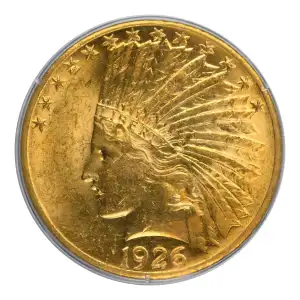By the early twentieth century, the designs of U.S. gold coins were long overdue for a makeover. The Liberty Head design had been employed on all gold coins for nearly 60 years with little modification. President Theodore Roosevelt took a personal interest in redesigning the nation’s gold coins and commissioned famed sculptor Augustus Saint-Gaudens to create new patterns for the $10 and $20 gold pieces, which debuted in 1907 with much fanfare. The obverse of the new $10 “gold eagle” depicted a bust of Liberty that was almost identical to the Nike head that Saint Gaudens designed for Sherman’s monument in New York City’s Central Park. Rather than a laurel crown, she wore a feathered war bonnet, paying homage to Native American Indians. LIBERTY was inscribed on the headdress, with 13 stars above the head and the date below. The reverse featured an American bald eagle standing on a bundle of arrows, among other inscriptions. Production of the $10 Indian continued yearly through 1916 and then only sporadically from 1920 to 1933. On April 5th, 1933, President Franklin D. Roosevelt signed Executive Order 6102, “forbidding the hoarding of gold coin, gold bullion, and gold certificates within the continental United States.” The order caused all gold coin production to cease, marking the end of a 140-year history of gold coin production in the United States. Today, the Indian Head Eagle remains a national relic of the “Golden Age” of American Numismatics, circulating alongside other enduring classics like the Saint Gaudens Double Eagle, Buffalo nickel, Mercury dime, and Walking Liberty Half dollar.


